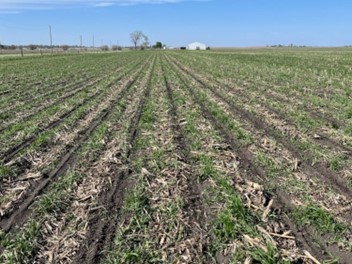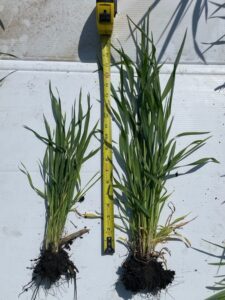As farmers emerge from winter and go about spring field activities, those who use cover crops are also evaluating their stands for success in establishment and overwintering. This year we are seeing more instances of certain species not overwintering as well as we might like. Barley is a winter cereal grain that has seen increased interest as a cover crop in the last few years as an alternative to cereal rye ahead of a corn crop. The advantage to barley is that it is slower to start vigorous growth in the spring time, allowing a wider window for termination at acceptable amounts of biomass. It also has a much lower overall mature biomass total if terminations are delayed due to wet weather. This gives some insurance that growth will not be too excessive and remove too much nitrogen ahead of a corn crop.

Strip-tilled soybeans planted into a barely cover crop.
Some of the downsides to using barley as a cover crop is it is generally more expensive than cereal rye per pound, and it is not as winter hardy as cereal rye. For those who have become used to the “throw it out on the concrete in December and it will grow” characteristics of cereal rye, the reduced winter hardiness of barley can be a disappointment. The winter hardiness of barley will vary depending on many things including the variety used and the winter weather we receive, but the best influence a farmer can have on good overwintering is timely and proper establishment.

Comparison of barley (left) and cereal rye (right) when seeded on the same day. Picture taken May 4th, 2024.
The proper timing of seeding barley will vary throughout the state of Illinois, the Midwest Cover Crop Council Selector Tool provides a good reference for seeding date that adapts depending on the county in Illinois you will be seeding in. The seeding dates in this tool are adjusted based on the average first frost date for each county. Since this tool is used as a guide for many cost share programs, it should be noted that the ideal times for establishment may be a little earlier than the final dates noted on the tool.
Another consideration for barley seeding is seeding depth. For those who are not used to winter grains management it is important to understand the negative effect frost heaving and exposure of the plant crown can have. While broadcasting barley on the soil surface can be an economical and effective way of establishment, it also can sometimes result in disappointing overwintering due to these effects. Appropriate seeding depths of 1 to 1.5 inches can help prevent frost heaving by anchoring the plant deeper in the ground and protect the crown of a small cereal plant from extreme cold and wind. Snow cover and insulation can also have a significant positive effect in helping barley overwinter. Therefore, extreme cold temperatures in northern areas will not necessarily result in winter kill if there is snow cover on the field. Fluctuations of temperatures on exposed fields will be the most damaging.
Unfortunately, over the last few years many parts of the state have been extremely dry in the fall, and earlier seeding dates of barley did not necessarily mean early establishment due to delayed germination. I am still a promoter of barley in front of corn and will continue to utilize it on our own farm and recommend it to others. Using it in a blend with other cover crops could provide more consistent benefits to cover cropping and taking steps towards proper seeding will help ensure success.
For more information on barley: